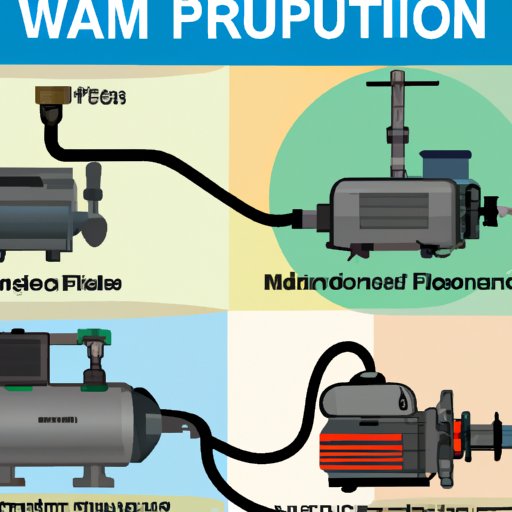Introduction
A vacuum pump is a device that creates a vacuum, or a space with very low pressure, by removing gas molecules from an enclosed space. Vacuum pumps are used in a variety of applications ranging from medical to industrial, and they are essential components in any system requiring a vacuum. In this article, we will explore what a vacuum pump is, the components of one, how they work, and why they are used.
Exploring the Components of a Vacuum Pump
Vacuum pumps typically consist of four main components: the vacuum chamber, the pump, the drive mechanism, and the exhaust system. The vacuum chamber is the container that holds the air or other gases that are to be removed from the system. The pump is the component that actually removes the gas from the chamber, while the drive mechanism powers the pump and can be either electric or mechanical. Finally, the exhaust system is the component that releases the gas molecules out of the system.

A Comprehensive Guide to Understanding Vacuum Pumps
Vacuum pumps come in a variety of shapes and sizes, and they can be used for a variety of purposes. Common types of vacuum pumps include rotary vane pumps, piston pumps, diaphragm pumps, and scroll pumps. Each type has its own advantages and disadvantages, and they are all suited for different applications. For instance, rotary vane pumps are best suited for applications requiring high flow rates, while piston pumps are best for applications requiring a high level of vacuum.
How Vacuum Pumps Work and Why They Are Used
Vacuum pumps use a process called “evacuation” to create a vacuum. During evacuation, the pump sucks the air or other gases out of the vacuum chamber, reducing the pressure inside the chamber. This decrease in pressure allows the desired effect to take place, such as the removal of contaminants or the creation of a seal. Vacuum pumps are used for a variety of purposes, such as vacuum drying, freeze drying, food packaging, vacuum forming, and vacuum distillation.

An Overview of Different Types of Vacuum Pumps
As mentioned above, there are several types of vacuum pumps available. Each type has its own advantages and disadvantages, so it’s important to understand which type is best suited for your application. Rotary vane pumps are the most common type of vacuum pump, and they are well-suited for applications requiring high flow rates. Piston pumps are best for applications requiring a high level of vacuum, while diaphragm pumps are great for applications that require both a high flow rate and a high level of vacuum. Scroll pumps are best for applications requiring a steady, even vacuum.
The Benefits of Using a Vacuum Pump
Using a vacuum pump offers many benefits, including increased efficiency, improved safety, and cost savings. Vacuum pumps create a more efficient environment by increasing the speed of processes, reducing the amount of energy required, and improving product quality. Vacuum pumps also improve safety by creating an environment free of hazardous materials and ensuring that proper safety measures are taken. Finally, vacuum pumps can reduce costs by decreasing energy consumption and waste.

Troubleshooting Common Issues with Vacuum Pumps
Although vacuum pumps are reliable devices, they can experience issues from time to time. Common problems include leaks, blocked lines, and insufficient vacuum. To troubleshoot these issues, it’s important to identify the source of the problem. If a leak is suspected, it’s important to check all seals and connections for damage. If a line is blocked, it’s important to clean or replace the line. Finally, if insufficient vacuum is the issue, it’s important to check the pump’s capacity and make sure that the correct size pump is being used.

Understanding Vacuum Pump Maintenance Requirements
Just like any other piece of equipment, vacuum pumps require regular maintenance to ensure optimal performance. The best way to maintain a vacuum pump is to follow a preventative maintenance plan. This includes regularly checking seals and connections, inspecting hoses and lines, and testing the system on a regular basis. It’s also important to have regular check-ups and inspections done by a qualified technician to ensure that everything is functioning properly.
Conclusion
In conclusion, vacuum pumps are essential components in any system requiring a vacuum. They come in a variety of shapes and sizes and can be used for a variety of purposes. Understanding the components of a vacuum pump, how they work, and why they are used is essential to getting the most out of them. Additionally, understanding the different types of vacuum pumps and their associated benefits is important for making the right choice. Finally, understanding the maintenance requirements of a vacuum pump is essential for ensuring optimal performance.


